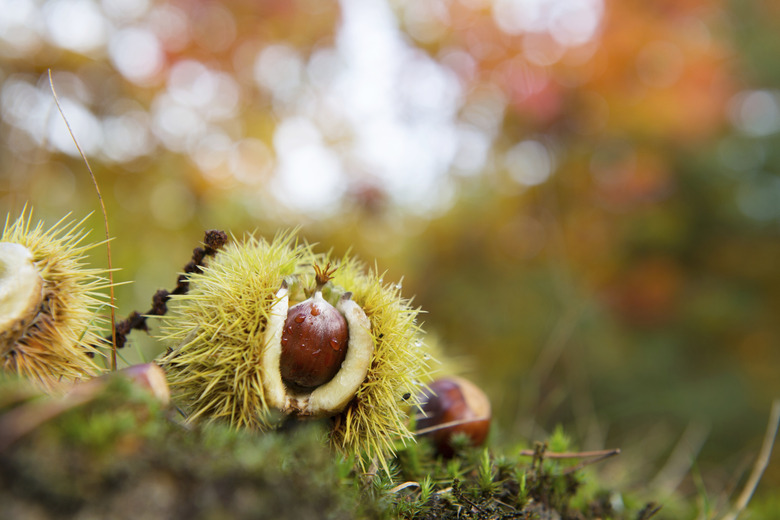Types Of Trees With Falling Nuts
We may receive a commission on purchases made from links.
Tree nuts are actually seeds that contain all the materials necessary to generate new trees, a process that happens after the nuts fall with the help of wind or rain. Unless the nuts find a suitable growing environment, however, they become a food source for mammals, such as deer and squirrels, as well as large birds, such as turkeys and crows. Humans have a stake in the process, too, because most nut trees, whether wild or domesticated, willingly release their bounty each fall, making nuts simple to harvest.
Production of Nut Trees
Production of Nut Trees
Although many nut trees native to the United States grow wild, certain varieties can be cultivated in a home garden, too. Some species, however, take years to become established, so you'll have to wait a long time before they produce a significant harvest.
Chestnut blight decimated large stands of the American chestnut tree (Castanea dentata) that once graced the eastern North American landscape from U.S. Department of Agriculture plant hardiness zones 4 through 8. Partially disease-resistant strains of the tree are available, though. A popular U.S. holiday treat, shiny brown, smooth-skinned chestnut tree nuts are encased in prickly green outer husks that turn yellowish-brown and drop from the tree in early to mid-fall.
Benefits of Growing Nut Trees
Benefits of Growing Nut Trees
Considering the price of nuts on supermarket shelves, it makes economic sense to grow a few nut trees, provided you have the space and don't mind waiting for them to start producing. Once the trees become established, they probably will more than pay for themselves in terms of the sizable crops they return.
Many nut trees, such as the American beech (Fagus grandifolia), are also useful as shade trees in addition to producing nuts. Hardy in USDA zones 3 through 9, the American beech produces spiky, brownish nuts in fall and shiny copper foliage.
Another option is the butternut tree (Juglans cinerea), which is hardy in USDA zones 3 through 7 and native to most of the eastern United States, west to Minnesota, and south to Arkansas and Georgia. Maturing in fall, its nuts are encased in hairy outer husks.
Drawbacks of Growing Nut Trees
Drawbacks of Growing Nut Trees
Some nut trees, including the shagbark hickory (Carya ovata), produce lots of debris in the form of leaves and twigs as well as nuts, particularly during years of bumper crops. Hardy in USDA zones 4 through 8, the shagbark hickory is native to parts of North America that range from southern Canada to Georgia and west to Texas.
The tree is named for its grayish bark that, at maturity, begins to curl and pull away from the trunk in long narrow strips. The nuts, which fall from the tree in late summer and early fall, measure no more than 1 inch in diameter and are encased in thick, spongy, green husks that resemble tiny pumpkins.
Oaks and Acorns
Oaks and Acorns
Although not typically an important food source for humans, oak trees (Quercus spp.), such as the white oak (Quercus alba), are valuable as shade trees and provide an important source of food for mammals and birds. The vast number of oak tree nuts, called acorns, falling in late summer to early fall, however, can be quite messy and interfere with lawn mowing and other yard maintenance.
The annual yield of acorns from the more than 60 species of oak trees in North America is greater than the annual combined yield from all other species of nut trees. Hardy in USDA zones 3 through 9, white oaks release their bounty of tan-brown acorns in September and October. Left where they fall, the nuts often germinate and develop into seedlings, which can be removed by hand.
